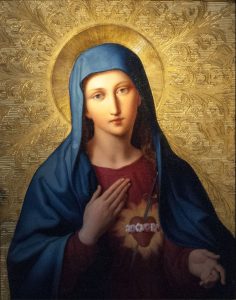
Mary, the Mother of God, the Immaculate Conception, the Perpetual Virginity, and the Assumption, form the four Marian Dogmas in the Catholic church and also the core Catholic Mariology. By Mariology, the Church explains the study of the person of Mary, her motherhood, as well as her major role in the history of salvation. Mary, having been preserved and chosen by God as the Mother of His Son, demonstrated her desire to accomplish the Divine initiative of God with her “Fiat” “Yes” to the will of God.
From the Annunciation account when the angel Gabriel visited Mary, the visit to Elizabeth where she praised God in her Magnificat, the Nativity account where she pondered the words of the Shepherds, the Presentation of Jesus in the temple where she had an encounter with the Simeon, the flight to Egypt with Jesus and Joseph, the losing of Jesus in the temple, the meeting of Jesus on His way to Calvary, her encounters with Jesus on the foot of the cross, all these events, Scripture tells us that Mary kept all these in her Heart and kept pondering on them (Luke 2:19, 34-35, 51.)
Despite all these joyful and sorrowful experiences Mary encountered in her life, her Heart remained clean, pure, blameless, and sparkling in the sight of God. Her Heart nurtured the burning love of humanity, the burning love of God, and her quest to convert souls for her beloved son. This is the Immaculate Heart of Mary.
While some church historians trace the origin of the devotion to Mary’s Heart around the late 11th and early 12th centuries from the likes of Saints Bernard of Clairvaux, Mechtilde, and Gertrude the Great, some other church historians included the likes of Saints Thomas Beckett, and Bridget of Sweden as the early devotees to the Immaculate Heart of Mary. Down the line, St. John Eudes, in the early 1600s publicly brought to limelight the devotion to the Immaculate Heart of Mary and the Sacred Heart of Jesus by creating a feast to honor the Heart of Mary and the formation of religious communities to promulgate the devotion to the Immaculate Heart.
To be precise, the devotion to the Cor Immaculatum Mariae (the Immaculate Heart of Mary) in the Catholic church gives us the clear picture of the interior life of Mary, her humble image, her joy, sorrows, perfections, virtues, and unfailing love to God and humanity. This devotion spread more after our Lady appeared to St. Catherine Laboure’ on 27 November 1830 with the Miraculous Medal. However, 25 years after the apparition of our Lady in Fatima, Pope Pius XII, on October 31,1946 consecrated the world to the Immaculate Heart of Mary, entrusting the world to the Virgin Mary as Queen of peace, through her Immaculate Heart and further proclaimed the Feast of the Immaculate Heart of Mary.
Following the Vatican II Council’s liturgical reformations in 1969, the feast of the Immaculate Heart of Mary that was celebrated on August 22 was moved to Saturday, a day after the Solemnity of the Sacred Heart of Jesus in June. No wonder then, in our churches, sacred places, homes, and offices, the picture of the “Two Hearts of Love” of Jesus and Mary are placed in strategic positions to remind us of that Divine union between Jesus and Mary whose love spring from the burning love to accomplish the plan of salvation.
With the celebration of the Immaculate Heart of Mary on Saturday after the Solemnity of the Sacred Heart of Jesus, the Congregation for the Doctrine of Faith, in her publication: “The Message of Fatima” and the Solimeo, Luis Sergio on “Fatima, A Message More Urgent than Ever” write; “The Five First Saturdays devotion is one of the principal points of the Fatima message. It centers on the urgent need for mankind to offer reparation and expiate for the many injuries that the Immaculate Heart of Mary suffers from the hands of both impious and indifferent men.” Thus, Sister Lucia, one of the visionaries of the Fatima apparition explains more that the Five First Saturdays correspond to the five kinds of offenses and blasphemies committed against the Immaculate Heart of Mary, which include; blasphemies against the Immaculate Conception, blasphemies against her virginity, blasphemies against her divine maternity, at the same time the refusal to accept her as the Mother of all men, instilling indifference, scorn and even hatred towards this Immaculate Mother in the hearts of children, and direct insults against Her sacred images.
Therefore, the devotion to the Immaculate Heart entails: going to make a good confession, attending a Holy Mass, receiving the Holy Eucharist, praying the five decades of the Rosary, and a 15-minute meditation on the mysteries of the Rosary. We cannot overlook the importance of the devotion in our lives as it helps to heal, mend, and bind our broken relationship with God and our Lady caused by our blasphemy and ingratitude perpetuated against the Immaculate Heart of Mary. It also offers us the opportunity to reconcile with God through the Sacrament of reconciliation (confession), and the recitation of the Holy Rosary. A devotion of this nature purifies the soul, especially when it is done with repentant heart.
For both our Deaf and hearing communities, we have decided to kick start this devotion from the first Saturday of this September to the first Saturday of January 2025 at St. Francis de Sales Parish, 15 Desales Ave. in Lebanon. It begins with confession at 8:00 am, Rosary, Mass by 9:00 am, and fellowship afterwards. Come one, come all. Let us collectively experience this beautiful encounter with our Lady through the devotion to her Immaculate Heart.
Immaculate Heart of Mary…Pray for us.
By Fr. Charles Onumaegbu
